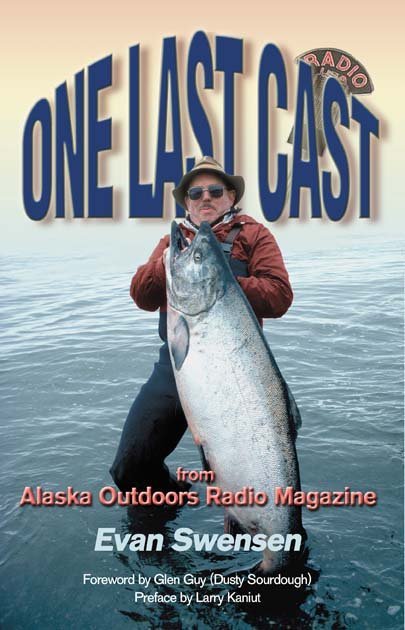One Last Cast
From Alaska Outdoors Radio Magazine
By Evan Swensen
Chapter Sixty-Seven
Mackey Maulers and Dogs

Gary Chilcote, our pilot-guide, informs Lee Fisher, my fishing partner, and me that the species of fish we intend to do battle with is “Chum salmon!”
“Chum salmon?” my mind asks. “Chum salmon! Call them by their real name. Dogs!” Dog salmon, I’m told, inherited their name from Alaska Natives who use the four other species of Pacific salmon for food, barter, or sale, and feed the chum to the dogs. Dogs are evil-looking salmon. Giant mouths with canine teeth give the appearance of a mad dog. The look is only superficial. They strike like an aged Saint Bernard on vacation and fight like a Mexican Chihuahua at siesta. The pigment on the skin adds a horrible appearance of pale pink with several rows of calico stripes. No other Alaska migratory fish can match it for ugliness.
Using a lure of his own making he calls a Mackey Mauler, Lee works his lure about 12 inches under the surface. About 20 feet from shore, a small wave follows the Mauler from a distance of 3 feet. Underneath the wave is undoubtedly a fish. With only 10 feet of line still out, the wave suddenly disappears, and the single hook on the Mackey Mauler comes up empty.
Lee casts again. We observe a moving mound of water, the telltale sign of attack. Like a ballistic missile at hypersonic speed, the fish moves in retaliation for missing on the first pass. Lee is also determined there will be no near miss. Neither fish nor angler is disappointed. The fish ensures a direct hit, striking with perfect accuracy.
Suddenly, breaking water, burst what I thought to be a small but active king. Now the salmon’s motives change. Seconds before, the lure had been the object of pursuit and capture, and it’s now escape and avoid. This change of heart creates a fighting fish on parity with any I’ve witnessed. The strike’s power would have pulled the rod from Fisher’s fingers had he not been fully prepared.
What I thought, at first impression, of being a king has changed my mind. Only a silver is out of the water like this fish. Adding evidence to my new thought is the bright silver light bouncing off his sides each time he decides to walk on water. Silvers exhibit tricks unknown to other salmon. This fish uses them all. First, he tries to escape by running away. When this doesn’t produce the desired result, he tries jumping, adding a few midair twists and turns. Then, reversing instantly from a 30-yard reel-ruining run, he directs his attack on the fisherman. The quick turnaround gives the fish the advantage of surprise. Now, moving right for Lee, in the opposite direction of seconds before, the fish takes charge. With slack in the line, he tries desperately to throw the hook. Ten feet from shore, he comes out of the water, shaking his head in a negative motion, and spits the hook at Lee’s feet. Now free of all containment, he swims away wiser for the experience. Lee, too, has been to school. The last 10 minutes have taught him a few lessons on landing lunkers.
Fired by the battle, Fisher makes another cast. As if in a rerun, the last strike repeats. The battle continues exactly as before, with only one variation. This time the quick turnaround is anticipated and planned for. The fish never gets ahead and ends up on the beach being photographed for Lee to carry in his wallet.
While photographing the catch, we make a discovery. It is neither king nor silver. The instigator of all this action is a dog—I mean chum salmon. Bright silver body without even a trace of calico stripes. No fanglike teeth. Just a beautiful fish. Full of energy and fight. Having not seen chums fresh from the ocean, I had surmised the creatures were born ugly.
I suspect future judgment of fish will be tempered by my experience in western Alaska, in early June, on a secret fishing river, close to salt water.


